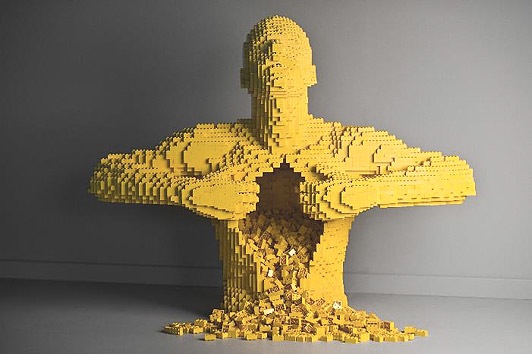
The Yellowstone Art Museum in Billings hosts “The Art of the Brick®,” an exhibition featuring large-scale sculptures created out of iconic LEGO® bricks by New York-based artist Nathan Sawaya. On display through Jan. 4, “The Art of the Brick” is one of the largest and most popular art exhibitions touring the globe, heralded by CNN as “one of the top 12 must-see exhibits in the world.”
“This year alone, we’ve visited Brussels, Dublin and Taiwan,” said Sawaya. “We are thrilled to be bringing this collection to Montana.”
Like most young kids, Sawaya started playing with LEGOs at a young age. But unlike most kids, Sawaya never stopped building, creating and exploring his own imagination. The result has solidified his place in pop culture history and he is making an indelible mark on the art world as well. The award-winning artist has catapulted the iconic LEGO brick into an art medium all its own, transforming this construction toy into awe-inspiring and thought-provoking sculptures.
The centerpiece of Sawaya’s collection of sculptures, and arguably his most famous piece of artwork, is “Yellow,” a LEGO torso of a man ripping open his chest while yellow plastic bricks cascade out of the cavity. Other sculptures depicts the human form in various states of emotion, including anger, love, depression and joy.
Originally from Oregon, Sawaya’s childhood dreams were always fun and creative. He drew cartoons, wrote stories, perfected magic tricks and, of course, played with LEGO®. When it came time for college, Sawaya moved to New York City, attended NYU and became a lawyer. But after years of million-dollar mergers and corporate acquisitions on Park Avenue, Sawaya realized he would rather be sitting on the floor creating art, than sitting in a board room negotiating contracts.
He walked away from the law and took an artistic risk on LEGO®. “I use LEGO bricks as my medium because I enjoy seeing people’s reactions to artwork created from something with which they are familiar,” says the artist. “Everyone can relate to it since it is a toy that many children have at home. I want to elevate this simple plaything to a place that it has never been before.”
“As so often in life, it’s a matter of perspective. Up close, the shape of the brick is distinctive. But from a distance, those right angles and distinct lines change to curves,” he adds.
For details, call 406-256-6804, or visit the website at www.artmuseum.org.